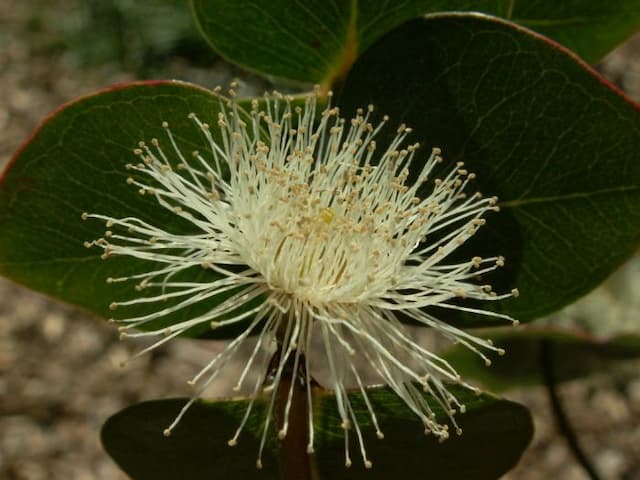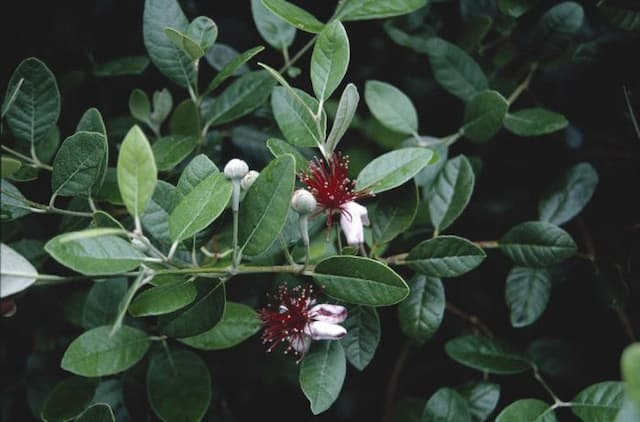Luma Amomyrtus luma

ABOUT
Amomyrtus luma, commonly known as the Luma, has a highly ornamental appearance. This evergreen shrub or small tree boasts a multi-branched structure with a smooth, flaking bark that reveals an array of colors beneath, typically in shades ranging from orange to gray. Its leaves are small, oval-shaped, and glossy, with a dark green hue that adds a lush look to its dense foliage. The Luma produces fragrant white or slightly pink-tinged flowers that blossom in clusters. These blooms are usually small and star-shaped, providing a delicate contrast to the robust greenery of the leaves. Following the flowering season, the Luma bears small, round fruits. These fruits can vary in color, maturing to a deep purple or black, and they often attract a variety of birds and wildlife to the plant. Overall, the appearance of the Luma is characterized by its richly colored bark, shiny leaves, and seasonal display of fragrant flowers and attractive berries. Its pleasing aesthetic makes it a sought-after choice for gardens and landscapes where a touch of natural beauty is sought without the need for large plants.
About this plant
 Names
NamesFamily
Myrtaceae.
Synonyms
Luma, Chilean Myrtle, Temu.
Common names
Luma chequen, Myrtus luma, Eugenia chequen, Myrceugenia luma.
 Toxicity
ToxicityTo humans
The plant commonly known as Luma is not widely reported to be toxic to humans. However, there is limited information available on its toxicity, and as with any plant, some individuals might be sensitive to it or its components. Generally, it's advised to avoid ingesting plants that are not confirmed to be edible, as they can potentially cause adverse reactions.
To pets
Similar to humans, Luma is not widely known to be toxic to pets. However, due to the limited information on the plant's potential toxicity, it is prudent to prevent pets from ingesting this or any unknown plants. Ingestion of non-edible plants by pets can sometimes lead to gastrointestinal upset or other health issues, so caution is advised.
 Characteristics
CharacteristicsLife cycle
Perennials
Foliage type
Evergreen
Color of leaves
Green
Flower color
White
Height
33 feet (10 meters)
Spread
13 feet (4 meters)
Plant type
Tree
Hardiness zones
9
Native area
Chile
Benefits
 General Benefits
General Benefits- Landscape Aesthetics: The Luma, with its attractive evergreen foliage and bark, can add year-round interest to gardens and landscapes.
- Habitat Support: It provides shelter and food for wildlife, including birds and beneficial insects.
- Erosion Control: The Luma's root system helps stabilize soil, preventing erosion on slopes and banks.
- Windbreak: When planted in rows, the Luma can act as a shield against strong winds, protecting soil and other plants.
- Privacy Screen: Its dense growth habit makes it suitable for use as a privacy hedge or living fence.
- Ornamental Fruit: The plant bears ornamental berries that can add color and interest to the winter garden.
 Medical Properties
Medical Properties- Antimicrobial: Amomyrtus luma has been reported to have antimicrobial properties, which may help in inhibiting the growth of certain bacteria and fungi.
- Anti-inflammatory: The plant may possess anti-inflammatory agents that can reduce inflammation in various conditions.
- Analgesic: There are indications that Amomyrtus luma might have pain-relieving properties that can alleviate different types of pain.
 Air-purifying Qualities
Air-purifying QualitiesThis plant is not specifically known for air purifying qualities.
 Other Uses
Other Uses- Luma wood is often valued for its hardness and density, making it suitable for high-quality flooring and fine woodworking projects.
- The wood's natural resistance to decay and insects allows for its use in outdoor constructions like decks and furniture.
- Luma's dense wood also has good burning properties, making it an excellent choice for use as firewood in colder regions.
- Craftspeople may use the burls and unique grain patterns of Luma wood to create decorative veneers and inlays for cabinetry and musical instruments.
- The plant's aromatic leaves can be utilized in potpourris or as a natural insect repellent in wardrobes and drawers.
- The berries of the Luma, when cooked and processed, can be used to make dyes suitable for textiles and handicrafts.
- With its dense foliage, Luma can be trimmed and shaped into hedges or topiaries in ornamental gardens.
- Luma branches are sometimes used in floral arrangements or as natural festive decorations during holiday seasons.
- The essential oils extracted from Luma leaves may be incorporated into natural perfumes or scented candles for their unique fragrance.
- Its attractive form and evergreen nature make Luma a popular choice for bonsai cultivation among enthusiasts.
Interesting Facts
 Feng Shui
Feng ShuiThe Luma is not used in Feng Shui practice.
 Zodiac Sign Compitability
Zodiac Sign CompitabilityThe Luma is not used in astrology practice.
 Plant Symbolism
Plant Symbolism- Resilience: Luma, or Amomyrtus luma, comes from tough environments which symbolizes its ability to thrive in challenging situations.
- Healing: Because of its medicinal properties, luma is often associated with healing and the restoration of health.
- Protection: In some cultures, the robust nature of the luma plant is seen as a symbol of protection against negative forces.
- Beauty: Luma has an attractive, often aromatic, presence, symbolizing natural beauty and simplicity.
- Eternity: The evergreen nature of luma reflects the concept of enduring life and immortality.
 Water
WaterThe Luma or Chilean Myrtle requires consistent moisture and should be watered regularly, making sure the soil is evenly moist but not waterlogged. During the growing season, typically spring to fall, water every week with approximately one to two gallons per week, depending on the size of the plant and environmental conditions. During the winter, reduce watering to every two to three weeks, allowing the top inch of soil to dry out slightly before watering again. Avoid overhead watering to prevent fungal diseases, and instead water directly at the base of the plant.
 Light
LightThe Luma prefers a spot with full sun to partial shade. It thrives best when receiving at least four to six hours of direct sunlight daily. However, in particularly hot climates, providing some afternoon shade can prevent leaf scorch. Choose a location that offers bright, indirect light for the majority of the day for optimal growth.
 Temperature
TemperatureThe Luma or Chilean Myrtle can survive in temperatures as low as 20 degrees Fahrenheit, although it grows best in temperate climates. Ideal temperatures for this plant range between 50 and 70 degrees Fahrenheit. Protect the plant from extreme cold and frost by providing shelter or moving it to a warmer location if necessary.
 Pruning
PruningPruning the Luma or Chilean Myrtle is done to maintain its shape, remove dead or damaged branches, and promote a bushier growth. It should be pruned in late winter or early spring before new growth begins. Prune any time to remove weak or crossing branches to allow for better air circulation. Prune up to one-third of the oldest stems to rejuvenate the plant if necessary.
 Cleaning
CleaningAs needed
 Soil
SoilFor Luma (the common name for Amomyrtus luma), the ideal soil mix is well-draining with plenty of organic matter. A mix of two parts peat or coconut coir, one part perlite, and one part compost is well-suited. The soil pH should be slightly acidic, around 6.0 to 6.5.
 Repotting
RepottingLuma should be repotted approximately every two to three years, or when it becomes root-bound. This allows for fresh soil and room for continued growth.
 Humidity & Misting
Humidity & MistingThe Luma plant thrives in moderate to high humidity conditions, ideally between 40-60%.
 Suitable locations
Suitable locationsIndoor
Place Luma in bright indirect light with high humidity.
Outdoor
Plant Luma in partial shade with protection from strong winds.
Hardiness zone
9-11 USDA
 Life cycle
Life cycleThe Luma (Amomyrtus luma) begins its life as a seed, which requires a moist and shaded environment to germinate. Germination is followed by the seedling stage, where the plant establishes its root system and initial leaves to harness sunlight and nutrients. As it grows into the juvenile stage, the Luma develops woody stems and true leaves, expanding its ability to photosynthesize and increase in size. Maturing into an adult plant, it produces flowers which, after pollination, develop into small, berry-like fruits containing seeds, completing its reproductive cycle. Seasonally, the Luma experiences periods of active growth and dormancy, influenced by environmental conditions. The life span of the Luma can extend over several decades, during which it continues to produce new seeds, thereby ensuring the survival of the species.
 Propogation
PropogationPropogation time
Spring to Summer
The Amomyrtus luma, commonly known as the Luma or Chilean myrtle, can be propagated by seed or cuttings, but the most popular method involves semi-hardwood cuttings. This process typically occurs during the summer months. To propagate by cuttings, a healthy, disease-free branch segment from the current or last year's growth is selected. This segment should be about 4-6 inches (10-15 cm) long with several leaves. The lower leaves are removed, and the cut end is dipped in rooting hormone to encourage root development. The cutting is then placed in a well-draining soil mix and kept moist but not waterlogged. Cuttings are usually kept in a warm area with indirect sunlight until roots develop, which may take several weeks.




